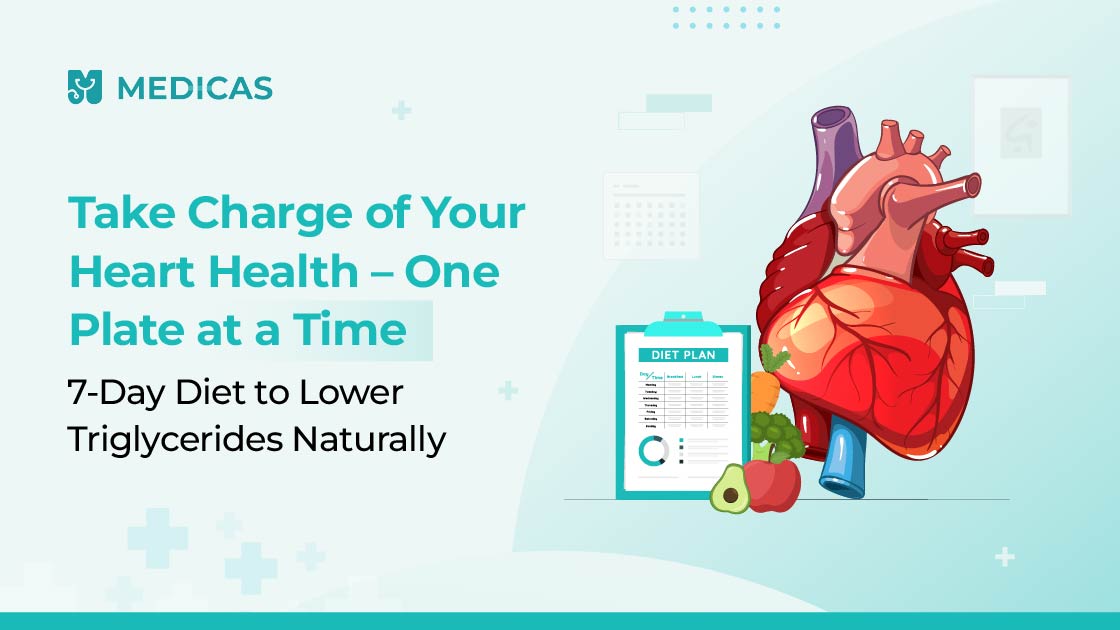Managing high blood fats can feel challenging, especially with busy routines and confusing advice. Yet, with a clear high-triglycerides diet plan and simple swaps in your kitchen, you can start seeing improvements within a week. This “7-day diet to lower triglycerides” is designed for everyday people, no exotic ingredients or complex cooking—just wholesome meals and doable habits.
Alongside delicious recipes, this blog will guide you on how to naturally lower triglycerides, increase fibre intake, and support heart health. We’ll also share home remedies and when to see a doctor or get a lipid test. Let’s get started!
Understanding Triglycerides and Their Impact on Health
What Are Triglycerides?
Triglycerides are a type of fat (lipid) found in your blood. After you eat, your body converts excess calories into triglycerides and stores them in fat cells. Later, hormones release them for energy between meals. While some triglycerides are essential, persistently high levels signal metabolic imbalance.
Causes of High Triglyceride Levels
Causes of high triglyceride levels include:
- Excess sugar and refined carbs intake.
- Sedentary lifestyle.
- Obesity or being overweight.
- Underlying conditions such as diabetes or hypothyroidism.
- Genetics.
- Excess alcohol.
- Certain medications.
Health Risks Associated with High Triglycerides
Untreated high triglycerides can lead to:
- Pancreatitis
- Increased risk of heart attacks and strokes
- Fatty liver disease
- Insulin resistance
Early diagnosis and a proper diet can prevent these outcomes.
Also Read: Natural Remedies: The Secret to Effective Obesity Treatment
Foods to Avoid for Lower Triglyceride Levels
List of Foods to Avoid with High Triglycerides
To reduce triglycerides and cholesterol naturally, steer clear of:
- Sugary drinks and sweets.
- Refined grains, such as white bread and pastries.
- Full-fat dairy and fatty meats.
- Trans fats in packaged snacks and baked goods
- Excessive alcohol, even small amounts, may elevate triglycerides in sensitive individuals.
These are foods to avoid triglycerides if you’re trying to maintain healthy lipid levels.
Hidden Sugars and Refined Carbs to Watch Out For
Sugar is one of the sneakiest contributors to high triglycerides, often hidden in:
- Flavoured yoghurts
- Breakfast cereals
- Packaged fruit juices
- Biscuits and cakes
Many snacks and sauces hide sugar under names like sucrose, glucose syrup, or maltodextrin—even so-called “healthy” granola bars can be high in sugar. Reading labels is essential to decreasing your triglycerides.
Processed Foods and Trans Fats to Cut Down
Hydrogenated oils, margarine, and trans fat can impair your lipid profile and increase triglycerides. Common sources include:
- Instant noodles
- Packaged chips and snacks
- Frozen parathas or ready meals
- Bakery items containing margarine
- Processed meats (sausage, bacon, deli cuts)
- Microwave meals
25 Foods to Lower Triglycerides Naturally
Vegetables, Fruits, and Whole Grains
Include the following in your foods to reduce triglycerides:
- Oats, ragi, and whole‑wheat rotis
- Apples, pears, papaya, and guava
- Berries: strawberries, blueberries (low‑sugar)
- Leafy greens: spinach, methi, fenugreek
- Cruciferous veggies: cauliflower, broccoli
- Sweet potatoes (boiled or steamed)
- Brussels sprouts (rich in antioxidants)
Heart-Healthy Fats and Lean Proteins
- Nuts: almonds, walnuts (small handful daily)
- Seeds: flaxseeds, chia seeds (ground)
- Fatty fish: salmon, mackerel (twice a week)
- Skinless poultry
- Low‑fat paneer and Greek yogurt
- Avocado (monounsaturated fats improve lipid ratios)
- Legumes (beans, lentils: protein + fibre)
Indian Foods That Help Reduce Triglycerides Naturally
If you’re wondering how to reduce triglycerides naturally with Indian food, here’s what to include:
- Turmeric (curcumin) in curries
- Garlic and ginger (anti‑inflammatory)
- Lemon water or jeera water (morning)
- Kalonji (nigella seeds)
- Curry leaves and kokum in dals
- Amla (Indian gooseberry) chutney
- Moringa (drumstick) sambar
- Green tea
- Buttermilk with jeera powder
- Mint and coriander chutney
- Makhana (fox nuts)
Your 7-Day Triglyceride-Lowering Diet Plan
Adopting a 7-day diet to lower triglycerides doesn’t mean bland food. It means smarter choices.
Day 1–3: Detoxing and Starting Light
- Breakfast: Warm lemon water; oats upma
- Mid‑morning: Amla juice or green tea
- Lunch: Brown‑rice khichdi with drumstick sambar
- Evening snack: Sprout chaat
- Dinner: Whole‑wheat roti, methi dal, mixed salad
Days 4–5: Incorporating Protein and Good Fats
- Breakfast: Besan chilla with spinach; mint chutney
- Mid‑morning: Walnuts and almonds
- Lunch: Quinoa pulao with veggies
- Evening snack: Buttermilk or lassi (low‑fat)
- Dinner: Grilled fish or tofu tikka; steamed broccoli
Day 6–7: Balanced Triglyceride-Friendly Meals
- Breakfast: Ragi dosa; coconut chutney
- Mid‑morning: Fresh fruit salad
- Lunch: Millet roti, mixed dal, sautéed greens
- Evening snack: Roasted chickpeas or murmura bhel
- Dinner: Moong dal stew; small portion of brown rice
Weekly Shopping List for the Diet
To make your 7-day diet to lower triglycerides seamless, stock up on:
- Whole grains
- Lean & plant proteins
- Low-fat dairy
- Antioxidant-rich produce
- Good fats
- Heart-healthy spices
If you need a more customised diet plan that is exclusively tailored to meet your lifestyle, you can consult with me directly via Medicas.
Lifestyle Tips to Lower Triglycerides Naturally
Exercise and Physical Activity Recommendations
Do 30+ minutes of moderate cardio (walking, cycling, swimming) most days to control triglyceride levels and raise HDL. Add strength training twice a week for improved metabolic health.
Staying Hydrated and Managing Stress
Drinking 2–3 liters of water daily helps your kidneys flush out excess fat. Chronic stress raises cortisol and harms lipids—manage with yoga, meditation, or deep breathing.
Importance of Sleep and Intermittent Fasting
Get 7–8 hrs of quality sleep to balance hormones and manage lipids. Intermittent fasting (16:8) may lower triglycerides and boost insulin sensitivity—check with your doctor first.
When to Seek Medical Help
Symptoms That Indicate You Should Consult a Doctor
- Unexplained fatigue
- Chest pain or tightness
- Numbness, tingling, or swelling in limbs
- Sudden weight gain
- Skin tags or fatty eye deposits
- Abdominal pain with nausea/vomiting (pancreatitis warning)
- Triglycerides consistently >200 mg/dL
If any of these symptoms appear, don’t delay, book an appointment with your doctor for instant advice. Online doctor consultations are very effective for personalised dietary
Also Read:The Role of Nutrition in Diabetes Management
How Online Medical Appointments Can Help
An online doctor consultation lets you review reports, adjust medications, and tailor your diet for high triglycerides from home. You can also book lab tests and schedule follow-ups easily. You can also consult with me directly through Medicas for a personalized diet chart and lifestyle-based recommendations
Digital Health Tools for Monitoring Triglyceride Levels
Wearable devices and health apps can track activity, sleep, and dietary intake. Pair them with home glucometers and lipid-profiling kits for real-time insights into your diet and triglyceride levels.
Conclusion
Adopting a 7-day diet plan to lower triglycerides and healthy lifestyle changes will improve heart health. Small steps matter. If you’re unsure, book an appointment or schedule an online doctor consultation for guidance. Here’s to better health!
Frequently Asked Questions
- What’s the difference between cholesterol and triglycerides?
Cholesterol builds cell walls and hormones; triglycerides store excess energy. Both matter for heart health, but are measured separately.
- How to reduce high triglyceride symptoms?
Focus on a high-omega-3 diet low in sugars and refined carbs, include foods rich in omega-3s, and follow home remedies like drinking lemon water and engaging in regular exercise.
- Should I book an online doctor appointment for triglycerides?
Yes—an online doctor consultation lets you review lipid reports, Book lab tests, and adjust your triglycerides diet safely.
- How to reduce triglyceride levels quickly and naturally?
Cut sugar and refined carbs, increase fibre, stay hydrated, exercise, and follow the 7-day diet to lower triglycerides. Include Indian foods like dal, oats, amla, and garlic in your diet regularly.
Related Blogs

Ms. Surbhi Upadhyay is a Dietitian and Nutritionist based in Agra, Uttar Pradesh, with 8 years of experience in clinical and therapeutic nutrition. She holds an M.Sc. in Food and Nutrition from Banasthali Vidyapith, Rajasthan, and has been actively involved in designing diet plans for weight management, cardiac care, and lifestyle-related conditions. For the past 3 years, she has worked as a Healthy Heart Failure Counselor and currently practices at Akashvani Agra. Ms. Upadhyay regularly contributes to public health awareness through her articles in leading newspapers, including Dainik Jagran, Amar Ujala, and Hindustan.


